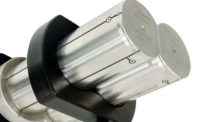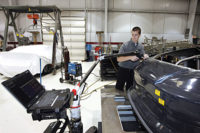Seems like everyone who fancies themselves an artist or performer uses—or overuses—the term “pushing the envelope” when describing their craft. However, if we journey back to the origins of the term we can regain the value of its meaning.
The term was first used in the field of mathematics. The mathematical envelope is defined as “the locus of the ultimate intersections of consecutive curves.” Huh? But this description from phrases.org helped me out:
“In a two-dimensional example, the set of lines described by the various positions of a ladder sliding down a wall forms an envelope, in this case an arc, gently curving away from the intersection of the wall and floor. Inside that envelope you will be hit by the ladder; outside you won’t.”
This is where we can start to see the aspects of the metaphor, the idea that there is an inside and outside of the envelope, that an envelope is a boundary. In the world of aviation and aeronautics, the term “flight envelope” has been used since World War II and “describes the upper and lower limits of the various factors that it is safe to fly at, that is, speed, engine power, maneuverability, wind speed, and altitude. By ‘pushing the envelope,’ that is, testing those limits, test pilots were able to determine just how far it was safe to go,” according to phrases.org.
So it is not surprising that the term was popular among test pilots profiled and dramatized by Tom Wolfe’s novel, and the subsequent movie, The Right Stuff (1979), which is how the metaphor was adopted and proliferated to the extent we hear it today where pushing the envelope means testing limits and trying out new, often radical ideas. In the area of personal growth, it also has come to mean venturing outside your comfort zone—where it is safe—to take risks and try new things, seemingly counter to the original mathematical example.
It’s difficult to deny the popularity of the metaphor, from mathematics to aviation to performing to self-help. For manufacturers, the envelope is being pushed by “The manufacturing industry continues to push the conventional boundaries of creating larger and more complex parts. The potential for costly errors also increases exponentially when producing large-scale, intricate components and assemblies. This emerging trend first initiated the idea of embedding metrology at touch points throughout the manufacturing process. What if a large part could be manufactured in a single process, and completely inspected and verified before it leaves the machine? What if this operation could be accomplished using a commercial-off-the-shelf robot?,” writes Joel Martin.
So check out “The New Science of Laser Trackers” and everything else we have to offer in this month’s Quality.
Enjoy and thanks for reading!
Darryl Seland,
Editorial Director


.jpg?height=200&t=1705603301&width=200)

